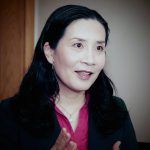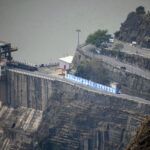Can Japan become a bridge-builder for nuclear disarmament?
By Masako Toki | August 19, 2015
Editor's note: To mark the presidential visit to Hiroshima, we are reprinting this August 2015 Bulletin column.
The recent, 70-year anniversaries of the atomic bombings of Hiroshima and Nagasaki offer a sobering opportunity to truly re-examine the real impact of the use of nuclear weapons—and not just take a sanitized view.
Because the age of the average survivor of the bombings, or “Hibakusha,” is now over 80, it is a race against time to pass on their experiences to the next generation. Hibakusha’s testimonials are poignant. Once you listen to them describing the effect of the use of nuclear weapons against human beings—indiscriminate mass murder that included not just instantaneous death for some, but lingering deaths from radiation sickness, burns, and spontaneous bleeding, among other horrific effects, as well as psychological agony—you will surely have different perspectives toward nuclear weapons. You soon realize that they are not just talking about the past, but they are also talking about the future—our shared future on this planet.
One of the most outspoken Hibakusha, Setsuko Thurlow, has been tirelessly working for nuclear disarmament by sharing her experiences. In her speech at the civil society session of the 2015 Nuclear Non-Proliferation Treaty (NPT) Review Conference, she highlighted the importance of youth continuing the work toward a world free of nuclear weapons. While frustrated by the slow progress in nuclear disarmament, Thurlow was still hopeful because of emerging youth activities and increasing momentum in the humanitarian initiative for nuclear disarmament.
Failure at the NPT. Bringing the humanitarian discussion to the nuclear weapons discourse is something that the Hibakusha have long hoped for. Over the past five years, this issue has gained significant momentum, and it was at the center of this year’s meeting.
For many Hibakusha, the 2015 NPT conference would be the last one that they will able to attend, given that the Treaty’s review conferences only occur once every five years (although there is a preparatory committee session in each of the three preceding years). So it was particularly disappointing to the elderly Hibakusha that this meeting ended without a final consensus document.
Deep divisions among the states that are party to the treaty are eroding the nuclear non-proliferation regime. While the failure to adopt the final document does not mean the outright demise of the treaty, the state parties must take more effective measures, with strong leadership, in order to make progress in nonproliferation and disarmament.
In the decades after the nuclear bombings, Japan has emerged as a leader in global nuclear nonproliferation, disarmament, and the peaceful use of nuclear energy. At the same time, North Korea and China’s nuclear weapons programs have called into question Japan’s reliance on the nuclear umbrella of the United States. That, along with Japan’s increasing stockpile of separated plutonium, is fanning concerns about Tokyo’s ultimate nuclear intentions.
Japan’s perennial reliance on the US nuclear umbrella is a huge obstacle for the country when it comes to taking a stronger stance in the humanitarian approach for nuclear disarmament. In fact, Japan has been reluctant to join this humanitarian initiative, and joined the initiative at the 2013 UN General Assembly largely because of massive public pressures—especially that of atomic bombing survivors in Hiroshima and Nagasaki.
While the humanitarian discussions gained overwhelming support from non-nuclear weapons states—especially from the Non-Aligned Movement countries—they also caused divisions between nuclear weapons states and non-nuclear weapons states. During the NPT review conference, there was no major player to bridge the gaps between the nuclear-weapon states, who insisted on a step-by-step approach, and the non-nuclear-weapon states, who insisted on creating a new legal framework to prohibit nuclear weapons entirely. Only continuing dialogues can help bring different perspectives even a little bit closer.
US breakthrough? Could Japan play a role in bridging the nuclear weapon states (mainly the United States) and the non-nuclear weapon states—in particular, the countries in the Non-Aligned Movement?
In April’s joint statement between the United States and Japan, the leaders of both countries declared “Hiroshima and Nagasaki will be forever engraved in the world’s memory. Concerns over the use of nuclear weapons underpin all work to reduce nuclear dangers and to work toward nuclear disarmament, to which all NPT parties are committed under Article VI of the treaty.” While the United States, like other nuclear weapons states, opposes any additional legal framework to prohibit nuclear weapons, at least the two countries clearly share the idea that there are catastrophic humanitarian consequences to nuclear weapons use.
Another groundbreaking development from the US side was that for the first time, the US government sent a high ranking official—Rose Gottemoeller, the US State Department’s under secretary for arms control and international security—to the 70-year anniversary ceremonies. (Although the US Ambassador to Tokyo has attended the ceremonies since 2010, this is the first time the United States sent a high-ranking official from Washington.)
The fact that a US official participated in the anniversary demonstrates that the United States is still committed to the goal of peace and security in a world free of nuclear weapons—as President Obama pledged to do in his monumental speech in Prague back in 2009. At the same time, Gottemoeller’s participation in the ceremonies in Hiroshima and Nagasaki could motivate Japan to be more vocal about its nuclear disarmament initiatives. This could enhance Japan’s credibility as a nuclear disarmament champion.
Humanitarian initiative. Japan is often faulted by domestic and international critics for its reliance on the nuclear umbrella of the United States as a pillar of Japan's national security policy; some say it undermines the goal of a nuclear-free world. To remedy this, Japan should consider taking more of a leadership role in the humanitarian initiative for nuclear disarmament.
Endorsing the ‘Humanitarian Pledge’ could be a first step. At the closing of the third conference of the Humanitarian Impact of Nuclear Weapons in Vienna in December 2014, Austria delivered the “Austrian Pledge” that calls for legally banning nuclear weapons, and invited all the states to join the pledge. (At the 2015 conference, the Austrian delegation announced that the pledge would be renamed as the “Humanitarian Pledge.”) As of July 2015, 113 states have endorsed the pledge.
The Humanitarian Pledge’s goal is to pursue effective measures to fill the legal gap that prevents the prohibition and elimination of nuclear weapons. It also seeks to stigmatize, prohibit, and eliminate nuclear weapons, in light of their unacceptable humanitarian consequences and associated risks. Although Japan’s official policy does not formally support this new legal framework to ban nuclear weapons, this does not mean that Japan continues to oppose the idea.
But Japan must take a bolder step, and come up with ways to enhance regional security with the United States while continuing to make efforts to engage the United States in the humanitarian initiative.
In his message to the 2015 NPT Review Conference, President Obama stated that “There are no shortcuts in this endeavor, and each step must be carefully taken to ensure that the security of all is increased along the way.” Efforts toward a world without nuclear weapons need to be multifaceted—which Japan knows better than many other countries.
A soured relationship with China, and security dilemmas. The tensions with Japan’s neighbors were clear at the NPT Review Conference, which attendees witnessed firsthand. When the Japanese delegation encouraged national leaders to visit Hiroshima and Nagasaki to understand the horror of the use of nuclear weapons, China opposed this idea because it felt that focusing on the plight of the two cities only gave a closeted, “partial interpretation” of the war. Atrocities in China during World War Two, such as the Japanese Army’s Nanjing Massacre, the forcible impressment of local civilian women for use as prostitutes or “comfort women,” and the “medical experiments” conducted upon prisoners of war by organizations such as Japan’s Unit 731 still loom large in the minds of Japan's neighbors these many years later—as do the hesitant, controversial nature of the apologies by Japanese officials, and the continual visits by major Japanese politicians to shrines that contain the remains of convicted war criminals. (Although the emperor of Japan—a ceremonial figure but one with great moral authority—has broken ranks to express “deep remorse.”) Perhaps with these wounds in mind, the Chinese delegation even said that Japan was bombed for a reason.
This scene at a major international diplomatic theater served as a microcosm of the sour relationship between the two countries. Only by acknowledging the past, and making some gestures of sincere atonement, can enough of a sense of trust be built that the two countries can work together more effectively for a world free of nuclear weapons. Without a sense of mutual trust and sustainable peace in the Asia Pacific region, it will be difficult for Japan to support further reductions in the numbers and role of nuclear weapons, and the region will be held hostage to its past.
At the ceremony, Hiroshima Mayor Matsui called nuclear weapons “an absolute evil” and the “ultimate inhumanity.” The mayor also stated that it is time to move on to start negotiation for a nuclear weapons convention to ban nuclear weapons. Prime Minister Shinzo Abe expressed his commitment to global dialogue, and said that Japan will continue to seek cooperation from both nuclear and non-nuclear countries to do even more to achieve a world without nuclear weapons.
There is no inherent contradiction to endorsing the idea to start negotiating a nuclear weapons convention while simultaneously engaging nuclear weapons states in dialogue. Tokyo should start thinking more seriously and creatively about what Japan can do to get one step closer to prohibition of nuclear weapons. Contrary to Tokyo's official policy, a majority of the general public hopes that the Japanese government will pursue security without relying on the US nuclear umbrella.
Overcoming the dilemma between disarmament advocacy and reliance on nuclear deterrence is not easy. It is the responsibility of current leaders to make more visible efforts toward the goal of a nuclear-free world. And at the same time, it is essential to educate the world’s youth so that may continue to work towards accomplishing the goal. Without tenacious efforts to educate succeeding generations, the goal of peace and security of a world without nuclear weapons will never be accomplished. And Japan must take steps in other areas as well.
Japan’s plutonium problem. To be a more effective player in nuclear disarmament Japan should seriously reconsider its fuel cycle policy. Japan has a controversial program for recycling spent nuclear fuel that has produced large quantities of plutonium in the form of metal-oxide nuclear fuel.
Once the reprocessing plant becomes fully operational it would separate about 8 metric tons of plutonium per year. As of 2014, Japan already possessed 47.8 metric tons of separated plutonium: 10.8 metric tons within the country and 37 metric tons in Britain and France. The guidelines of the International Atomic Energy Agency (IAEA) say that as little as 8 kilograms of separated plutonium could be used to make a nuclear weapon. That fact has raised nuclear security concerns in the US government—and fears among other countries in the region—that this stockpile could form the backbone of a Japanese nuclear weapons program. In turn, this fear encourages others to consider generating their own stockpile. Moreover, Japan’s stockpile of separated plutonium is likely to grow in the near future, because it will take at least a few years to make the reprocessing plant operational and to fabricate this separated plutonium into the mixed oxide fuel that could be burned in a reactor.
A growing stockpile of separated plutonium is against Japanese policy and the IAEA guidelines to which Japan adheres. Consequently, in order for Japan to be truly trusted in nonproliferation and disarmament, the current nuclear fuel cycle policy needs to be seriously reviewed with several different options. It will not be easy in any way to shift ingrained, established policy, but, if successful, it could mitigate concerns from Japan’s neighboring countries. Improving Japan’s relationship with other Asian countries is one of the keys to promote nuclear disarmament.
Preparing the next generation. With these issues in mind, the Center for Nonproliferation Studies in Monterey, California—where I work—has been implementing a project to promote disarmament and nonproliferation education to high school students around the world, including the United States, Japan, and Russia. This April, we brought US and Russian students to Hiroshima for the conference to commemorate the 70th anniversary of the atomic bombings. To further enhance their understanding of the horror of nuclear weapons use, participants visited the Hiroshima Peace Memorial Museum and heard a first-hand account of August 6, 1945 from a Hibakusha. Students learned about nuclear disarmament issues, the impact of the use of nuclear weapons, and the challenges inherent in achieving a world free of nuclear weapons. Most importantly, many of these students realized that they are the ones who are responsible to achieve that goal.
The United Nations Secretary-General Ban Ki-moon, in a speech on disarmament in Monterey two years ago, eloquently stated: “Education can also help to refute the claim that nuclear disarmament is utopian … Education can help the world to build a global culture of peace that rejects all weapons of mass destruction as illegitimate and immoral.”
The power and promise of education to achieve this goal should be more widely recognized by world leaders. The recent 70th anniversary ceremonies would be the appropriate place to start to strengthen this effort.
Together, we make the world safer.
The Bulletin elevates expert voices above the noise. But as an independent nonprofit organization, our operations depend on the support of readers like you. Help us continue to deliver quality journalism that holds leaders accountable. Your support of our work at any level is important. In return, we promise our coverage will be understandable, influential, vigilant, solution-oriented, and fair-minded. Together we can make a difference.
Topics: Nuclear Weapons, Opinion, Special Topics















